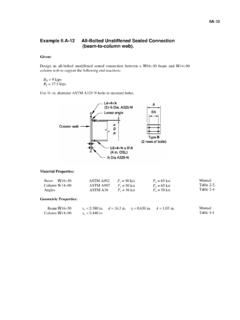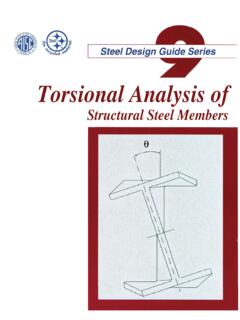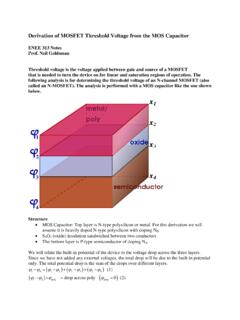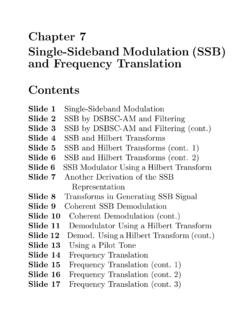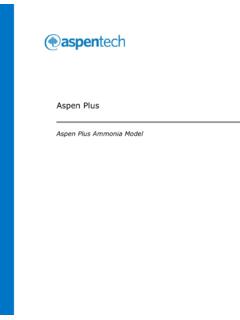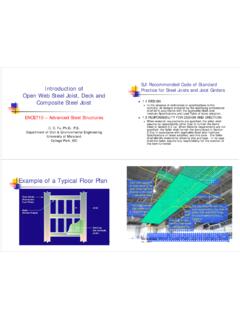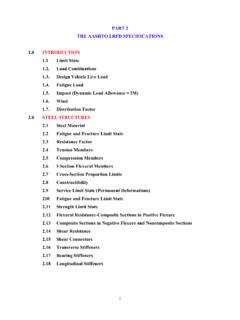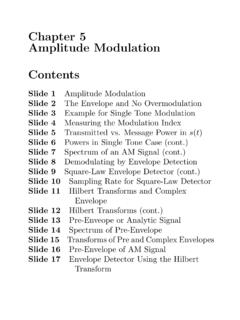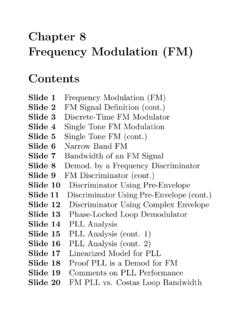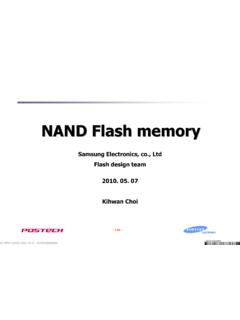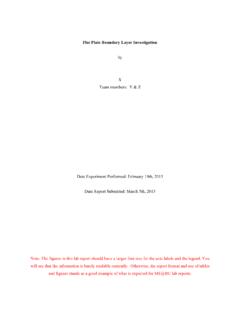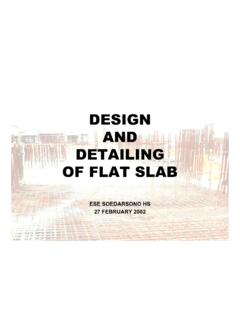Transcription of Analysis of Statically Determinate Trusses
1 1!Common Types of Trusses !Classification of Coplanar Trusses !The Method of Joints!Zero-Force Members!The Method of Sections!Compound Trusses !Complex Trusses !Space TrussesAnalysis of Statically Determinate Trusses2 Common Types of Trussesgusset plate Roof Trussestop cordroofpurlinsknee bracebottom cordgusset platespan, 18 - 30 m, typicalbay, 5-6 m typical3 Howe truss18 - 30 mPratt truss18 - 30 mHowe trussflat roofWarren trussflat roofsaw-tooth trussskylightFink truss> 30 mthree-hinged archhangar, gymnasium4 Bridge Trussestop corddecksway bracingtop lateralbracingstringersportal end postportalbracingpanelfloor beambottom cord5trough Pratt trussdeck Pratt trussWarren trussparker truss(pratt truss with curved chord)Howe trussbaltimore trussK truss61.
2 All members are connected at both ends by smooth frictionless All loads are applied at joints (member weight is negligible).Notes: Centroids of all joint members coincide at the joint. All members are straight. All load conditions satisfy Hooke s for Design7 Classification of Coplanar Trusses Simple Trussesabcd (new joint)new membersABCDPCDABPPABC8 Compound Trussessimple trusssimple trussType 2simple trusssimple trussType 1secondary simple trusssecondary simple trusssecondary simple trusssecondary simple trussmain simple trussType 39 Complex Trusses Determinacyb + r = 2jstatically determinateb + r > 2jstatically indeterminateIn particular, the degree of indeterminacy is specified by the difference in thenumbers (b + r)
3 - Stabilityb + r < 2junstableb + r 2junstable if truss support reactions are concurrent or parallelor if some of the components of the truss form a collapsiblemechanism>External UnstableUnstable-parallel reactionsUnstable-concurrent reactions11 ABCDEFOI nternal Unstable8 + 3 = 11 < 2(6)AD, BE, and CF are concurrent at point O12 Example 3-1 Classify each of the Trusses in the figure below as stable, unstable, staticallydeterminate, or Statically indeterminate. The Trusses are subjected to arbitraryexternal loadings that are assumed to be known and can act anywhere on stable, since the reactions are not concurrent or parallel. Since b = 19,r = 3, j = 11, then b + r = 2j or 22 = 22. Therefore, the truss is Statically inspection the truss is internally stable.
4 Since b = 15, r = 4, j = 9, then b + r > 2j or 19 > 18. The trussis Statically indeterminate to the first degree. By inspection the truss is stable. Since b = 9, r = 3, j = 6, then b + r = 2j or 12 = 12. The truss is Statically Determinate . By inspection the truss is internally stable. Since b = 12, r = 3, j = 8, then b + r < 2j or 15 < 16. The truss is internally m2 m500 N45oABCThe Method of JointsCy = 500 NFBAFBC500 NB45oJoint Bxy Fx = 0:+500 - FBCsin45o = 0 FBC = 707 N (C) Fy = 0:+- FBA + FBCcos45o = 0 FBA = 500 N (T)Ax = 500 NAy = 500 N162 m2 m500 N45oABCCy = 500 NAx = 500 NAy = 500 NFAC Fx = 0:+500 - FAC = 0 FAC = 500 N (T)Joint A500 N500 N500 N17 Zero-Force MembersDxDyEyCFCDFCB Fx = 0: FCB = 0+ Fy = 0:FCD = 0+FAEFABA Fy = 0:FABsin = 0,FAB = 0 + Fx = 0: FAE + 0 = 0, FAE = 0+0000 PABCDE18 Example 3-4 Using the method of joints, indicate all the members of the truss shown in thefigure below that have zero D Fy = 0:+ FDCsin = 0, FDC = 0 Fx = 0:+FDE + 0 = 0,FDE = 00 FECFEFPEFEF = 0 Fx = 0.
5 +Joint EAxAxGx000xyD FDCFDE20 Joint H Fy = 0:+ FHB = 0 AxAxGxJoint G Fy = 0:+FGA = 000000 FHFFHAFHBxyHGGxFGFFGAPABCDEFGH212 kN2 kN2 kNABCDEF1 kNGHIJK5@3m = 15 m5 mExample 3-5 Determine all the member forces Identify zero-force members222 kN2 kN2 kNABCDEF1 kNGHIJK5@3m = 15 m5 mSOLUTIONr + b = 2j,4182(11) Determinate Stable+ MA = 0:0)12(1)9(2)6(2)3(2)5(= xKKx = kN, Fx = 0:+, + xAAx = kN, Fy = 0:+,01222= yAAy = 7 kN,KyKxAyAx0 Use method of joints232 kN2 kN2 kNABCDEF1 kNGHIJK5@3m = 15 m5 m07 kNFx y 00 Joint FFFE FFG F x = 0:+FFG = 0 F y = 0:+0sin= FEFFFE = 0 Use method of joint 242 kN2 kN2 kNABCDEF1 kNGHIJK5@3m = 15 m5 m07 kN00 F x = 0:+-FED = 0 F y = 0:+0cos= EGFFEG = 0y Ex FED0 FEG Joint E252 kN2 kN2 kNABCDEF1 kNGHIJK5@3m = 15 m5 m07 kN00 F x = 0:+FHG = kN (T) F y = 0:+ oDGFFDG = kN (C) Joint GFHG FDG 01 kNGx y )32(tan1== + HGF262 kN2 kN2 kNABCDEF1 kNGHIJK5@3m = 15 m5 m07 kN0 FHI Joint HHx y kNFHD F y = 0:+FHD = 0 F x = 0:+FHI = kN (T) + kNDEF1 kNGH3 m3 m3 m Use method of + MD = 0:0)3(1)2(= HIFFHI = kN (T)+ MF = 0:0)6(2)3(1)9( ++ DIFFDI = 3 kN (T)+ MI = 0:0)3(2)6(1)9( DCFFDC = kN (C)Check F y = 0:+ 3 Method of SectionsExDxDyaa100 NABG2 m45oFGFFGCFBC+ MG = 0:100(2) - FBC(2) = 0 FBC = 100 N (T) Fy = 0:+-100 + FGCsin45o = 0 FGC = N (T)+ MC = 0.
6 100(4) - FGF(2) = 0 FGF = 200 N (C)100 NABCDEFG2 m2 m2 m2 m292 kN2 kN2 kNABCDEF1 kNGHIJK5@3m = 15 m5 mExample 3-6 Determine member force CD, ID, and kNDEF1 kNGH3 m3 m3 m Use method of + MD = 0:0)3(1)2(= HIFFHI = kN (T)+ MF = 0:0)6(2)3(1)9( ++ DIFFDI = 3 kN (T)+ MI = 0:0)3(2)6(1)9( DCFFDC = kN (C)Check F y = 0:+ 3 + + + +0031 Example 3-7 Determine the force in members GF and GD of the truss shown in the figurebelow. State whether the members are in tension or compression. The reactions atthe supports have been kN8 kN2 kNAx = 0Ay = 9 kNEy = 7 kNABC DEFGH3 m3 m3 m3 m3 m32Ax = 0Ay = 9 kNSOLUTIONaa+ MD = 0:FFG ( ) + 7(3) = 0, FFG = kN (C)+ MO = 0:- 7(3) + 2(6) + FDG (6) = 0, FDG = kN (C)6 kN8 kN2 kNEy = 7 kNABC DEFGH3 m3 m3 m3 m3 m2 kNEy = 7 kNDEFS ection a-a3 mFFGFDGFDC3 3-8 Determine the force in members BC and MC of the K-truss shown in the figurebelow.
7 State whether the members are in tension or compression. The reactions atthe supports have been FGHIJKLMNOP6 kN6 kN8 kN7 kN13 kN03 m3 m5 m5 m5 m5 m5 m5 m34 SOLUTIONaaSection a-aABL6 kN13 kN5 m6 mFLKFBMFLMFBC+ ML = 0:FBC(6) - 13(5) = 0, FBC = 10 kN (T)ABCDE FGHIJKLMNOP6 kN6 kN8 kN7 kN13 kN03 m3 m5 m5 m5 m5 m5 m5 m35bbFKLFKMFCM10 kN+ MK = 0:-FCMcos31o(6) - 10(6) - 8(5) + 7(20) = 0 FCM = kN (T)31oABCDE FGHIJKLMNOP6 kN6 kN8 kN7 kN13 kN03 m3 m5 m5 m5 m5 m5 m5 mCDE FGHIJKNOP6 kN8 kN7 kN3 m3 m5 m5 m5 m5 m36 Compound TrussesProcedure for AnalysisStep 1. Identify the simple trussesStep 2. Obtain external loadingStep 3. Solve for simple Trusses separately37 Example 3-9 Indicate how to analyze the compound truss shown in the figure below.
8 Thereactions at the supports have been kN2 kN4 kNCD4 m2 m2 mEy = 5 kNAy = 5 kNAy = 0 IHJKFEG2 m2 m2 m2 m38 SOLUTIONaaCFHGFBCFJC4 sin60o mAB4 kNAy = 5 kNIHJ2 m2 m+ MC = 0:-5(4) + 4(2) + FHG(4sin60o) = 0 FHG = kN (C)AB4 kN2 kN4 kNCD4 m2 m2 mEy = 5 kNAy = 5 kNAy = 0 IHJKFEG2 m2 m2 m2 m39AB4 kN2 kNCAy = 5 kNIHJ2 m2 m4 sin60o kN+ MA = 0 (4sin60o) + FCKsin60o(4) - 4(2) - 2(4) = 0 FCK = kN (T)FCKFCD60o Fx = 0:+ + + FCD = 0 FCK = kN (T)AB4 kN2 kN4 kNCD4 m2 m2 mEy = 5 kNAy = 5 kNAy = 0 IHJKFEG2 m2 m2 m2 m40AB4 kN2 kNCAy = 5 kNIHJ2 m2 m4 sin60o kNFCK = kN60oUsing the method of A : Determine FAB and FAIJ oint H : Determine FHI and FHJJ oint I : Determine FIJ and FIBJ oint B : Determine FBC and FBJJ oint J : Determine FJCAB4 kN2 kN4 kNCD4 m2 m2 mEy = 5 kNAy = 5 kNAy = 0 IHJKFEG2 m2 m2 m2 m41 Example 3-10 Indicate how to analyze the compound truss shown in the fugure below.
9 Thereactions at the supports have been m2 m2 m2 m2 m2 m15 kN15 kNAy = 15 kNAx = 0 kNFy = 15 kN4 m42 SOLUTIONaa+ MB = 0:-15(2) - FDG(2 sin45o) - FCEcos45o(4) - FCEsin45o(2) = 0 -----(1) Fy = 0:+15 - 15 + FBHsin45o - FCEsin45o = 0 FBH = FCE-----(2) Fx = 0:+FCEFBHFDGABCD45o45o2 m2 m2 m15 kNAy = 15 kN4 m45o2 sin 45o m FBHcos45o + FDG + FCEcos45o = 0-----(3)From eq.(1)-(3): FBH = FCE = kN (C) FDG = kN (T)ABCDEFGH45o45o45o2 m2 m2 m2 m2 m2 m15 kN15 kNAy = 15 kNAx = 0 kNFy = 15 kN4 m43 From eq.(1)-(3): FBH = FCE = kN (C) FDG = kN (T) Analysis of each connected simple truss can now be performed using the method of A : Determine FAB and FADJ oint D : Determine FDC and FDBJ oint C : Determine FCBaaABCD45o45o2 m2 m2 m15 kNAy = 15 kN4 m45oABCDEFGH45o45o45o2 m2 m2 m2 m2 m2 m15 kN15 kNAy = 15 kNAx = 0 kNFy = 15 kN4 mFCEFBHFDG44 Example 3-11 Indicate how to analyze the symmetrical compound truss shown in the figurebelow.
10 The reactions at the supports have been kN3 kN3 kNACEBFDGH45o45oAy = kNAx = 0 kNFy = kN6 m6 m5o5o5o5o453 kN3 kNEFGAFAEFAE5 kN3 kN3 kNACEBFDGH45o45oAy = kNAx = 0 kNFy = kN6 m6 kN5 kNE Fy = 0:+ - - FAEsin45o = 0 FAE = kN (C) Fx = 0:+ - + FAB = 0 FAB = kN (T) kN45oFAEFAB5 kN3 kN3 kNACEBFDGH45o45oAy = kNAx = 0 kNFy = kN6 m6 m5o5o5o5o4711 Complex Trusses +=X xF EC + x f EC = 0x =F ECf ECr + b = 2j,392(6) Determinate StableF EC= FADFADf ECFi = F i + x f iPABCDFEPABCDFEPABCDFE48 Example 3-12 Determine the force in each member of the complex truss shown in the figurebelow. Assume joints B, F, and D are on the same horizontal line. State whetherthe members are in tension or kNABCDEF1 m1 m49 SOLUTION+=x F'BD+ x f BD = 0x =F'BDf BDFi = F'i + x f i45o45o20 kNABCDEF45o45oABCDEF1 kN45o45o20 kNABCDEF1 m1 m50x 45o45o20 kNABCDEF+45o45oABCDEF1 +10100)1(100==+ =+xxxfFBDBDF irst determine reactions and next use the method of joint, start at join C, F, E, D, and kN( )
